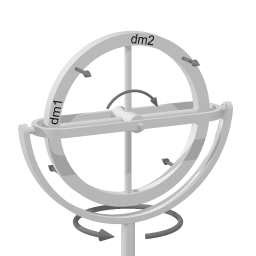Image: Gyroscopic precession 256x256
Description: Turnable gimbal holding gyro. Labelled to explain coriolisforces as reason of momentum generated by applying a momentum to the gyro. Suitable to explain precession as well as self-actuating orientation to north of a gyrocompass. From inside to outside there are three axes of rotation: the hub of the wheel, the gimbal axis and the vertical pivot. To distinguish between the two horizontal axes, rotation around the wheel hub will be called 'rolling,' and rotation around the gimbal axis will be called 'pitching.' First, imagine that the device is rotating around the pivot axis. Then some rotation around the wheelhub is added. Imagine the gimbal axis to be locked, so that the wheel cannot pitch. The gimbal axis has sensors, that measure whether there is a torque around the gimbal axis. The device is spinning around the vertical axis, and then some roll is added. In the picture, a section of the wheel has been named 'dm1'. When the rolling starts, section dm1 is at the perimeter of the spinning motion. Section dm1 has a lot of velocity and as it is forced closer to the center of rotation, it tends to move in the direction of the top-left arrow in the diagram (shown at 45o in the direction of rolling). Section dm2 of the wheel starts out at the center of rotation, and thus initially has zero velocity. A force would be required to increase section dm2's velocity to the velocity at the perimeter of the pivot axis' plane. If that force is not provided then section dm2's inertia will make it move in the direction of the top-right arrow. Note that both arrows point in the same direction. The same reasoning applies for the bottom half of the wheel, but there the arrows point in the opposite direction to that of the top arrows. Combined over the entire wheel, there is a torque around the gimbal axis when some rolling is added to rotation around a vertical axis. It is important to note that the torque arises without any delay; the response is instantaneous.
Title: Gyroscopic precession 256x256
Credit: Image created with the help of POV-ray ray-tracing software.
Author: Cleonis at en.wikipedia
Usage Terms: Creative Commons Attribution-Share Alike 2.5
License: CC BY-SA 2.5
License Link: https://creativecommons.org/licenses/by-sa/2.5
Attribution Required?: Yes
Image usage
The following 2 pages link to this image:


